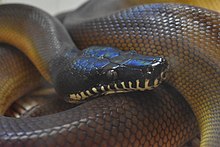D'Albertis' python (Leiopython albertisii), also known commonly as D'Albert's water python or the northern white-lipped python, is a species of python, a non-venomous snake in the family Pythonidae. The species is endemic to New Guinea. There are no subspecies that are recognized as being valid.[4]
| D'Albertis python | |
|---|---|

| |
| Scientific classification | |
| Domain: | Eukaryota |
| Kingdom: | Animalia |
| Phylum: | Chordata |
| Class: | Reptilia |
| Order: | Squamata |
| Suborder: | Serpentes |
| Family: | Pythonidae |
| Genus: | Leiopython |
| Species: | L. albertisii
|
| Binomial name | |
| Leiopython albertisii | |
| Synonyms | |
| |
Geographic range and habitat
editL. albertisii is found in most of New Guinea below 1,200 m (3,900 ft), including the islands of Salawati and Biak, Normanby, Mussau and Emirau,[5] as well as a few islands in the Torres Strait.
The type locality given is "Kapaor in Nova Guinea boreali occidentali ... et prope Andai ". The authors also stated localities for two additional specimens: "... un esemplare a Kapaor fra i Papua Onin..." and "... un secondo esemplare ad Andai presso Dorei..." (= Kapoar, Onin Peninsula and Andai, near Dorei, Irian Jaya, Indonesia).[2]
Some doubt can be cast on its occurrence on Normanby, as McDowell (1975)[6] had erroneously assigned Bara Bara to this island, rather than to the mainland of Papua New Guinea[5] in Milne Bay Province as stated by Boulenger (1898)[7] and Koopman (1982).[8]
Etymology
editThe specific name, albertisii, is in honor of Italian explorer Luigi D'Albertis.[9][10]
Description
editFemale adults of L. albertisii grow to an average of about 213 cm (6–7 ft) in total length (including tail). Both sexes are patternless, except for some light markings on the postoculars. The dorsum of the head is shiny black, and the upper and lower labial scales are white with black markings on the anterior edge of the scales. Body color is either brownish-violet fading to yellowish ventrally or blackish-blue fading to gray.
Behavior
editAlthough mostly terrestrial, L. albertisii can and is known to occasionally climb.[11] White-lipped pythons are reportedly aggressive, though this is reduced in those born and raised in captivity.[12] L. albertisii also has been observed to regularly regurgitate fur balls from its prey.[13]
Diet
editThe diet of L. albertisii includes a range of small-sized to medium-sized birds and mammals.[14] Neonates and juveniles often feed on lizards. Heat sensitive pits in the upper and lower jaws are used to help locate prey during nocturnal hunting.[11]
Reproduction
editL. albertisii is oviparous. A sexually mature female may lay a clutch of about a dozen eggs. The eggs stick together in a compact pile, and the female coils around them. The hatchlings emerge after about two months of incubation and are about 38 cm (15 in) in length.[14]
References
edit- ^ Tallowin, O.; Allison, A.; O'Shea, M.; Parker, F. (2018). "Leiopython albertisii ". IUCN Red List of Threatened Species. 2018: e.T199628A2607789. doi:10.2305/IUCN.UK.2018-2.RLTS.T199628A2607789.en. Retrieved 18 November 2021.
- ^ a b McDiarmid RW, Campbell JA, Touré TA (1999). Snake Species of the World: A Taxonomic and Geographic Reference, Volume 1. Washington, District of Columbia: Herpetologists' League. 511 pp. ISBN 1-893777-00-6 (series). ISBN 1-893777-01-4 (volume).
- ^ Species Bothrochilus albertisii at The Reptile Database . www.reptile-database.org.
- ^ "Leiopython". Integrated Taxonomic Information System. Retrieved 9 September 2007.
- ^ a b Schleip, Wulf D. (2008). "Revision of the genus Leiopython Hubrecht 1879 (Serpentes: Pythonidae) with the redescription of taxa recently described by Hoser (2000) and the description of new species". Journal of Herpetology. 42 (4): 645–667. doi:10.1670/06-182R5.1.
- ^ McDowell SB (1975). "A catalogue of the snakes of New Guinea and the Solomon’s, with special Reference to Those in the Bernice P. Bishop Museum. Part II". (24.02.1975). Journal of Herpetology 9 (1): 1-79.
- ^ Boulenger GA (1898). "An account of the reptiles and batrachians collected by Dr. L. Loria in British New Guinea". Annali del Museo Civico di Storia Naturale di Genova, Series 2, 18: 694-710.
- ^ Koopman KF (1982). "Results of the Archibold Expedition No. 109. Bats from Eastern Papua and the East Papua Islands". American Museum Novitates (2747): 1-34.
- ^ Peters W, Doria G (1878). "Catalogo dei rettili e dei batraci raccolti da O. Beccari, L. M. D'Albertis e A. A. Bruijn nella sotto-regione austro-malese ". Annali del Museo Civico di Storia Naturale di Genova, Series 1, 13: 323-450. ("Liasis Albertisii ", new species, pp. 401-403 + Plate III, Figure 2). (in Italian and Latin).
- ^ Beolens, Bo; Watkins, Michael; Grayson, Michael (2011). The Eponym Dictionary of Reptiles. Baltimore: Johns Hopkins University Press. xiii + 296 pp. ISBN 978-1-4214-0135-5. (Leiopython albertisii, p. 64; L. bennettorum, p. 22).
- ^ a b "Bothrochilus albertisii ". Retrieved 14 December 2016. Cold Blood Creations.
- ^ "White Lipped Python". Python Snake Database. Snake Estate. Retrieved 14 December 2016.
- ^ Schleip, Wulf (June 2009). "Leiopython albertisii (Northern White-Lipped Python). Behavior" (PDF). Herpetological Review. 40 (2): 231. Retrieved 14 December 2016.
- ^ a b Mehrtens JM (1987). Living Snakes of the World in Color. New York: Sterling Publishers. 480 pp. ISBN 0-8069-6460-X.
Further reading
edit- Cogger HG (2014). Reptiles and Amphibians of Australia, Seventh Edition. Clayton, Victoria, Australia: CSIRO Publishing. xxx + 1,033 pp. ISBN 978-0643100350. (Leiopython albertisii, p. 821).
- Reynolds, R. Graham; Niemiller, Matthew L.; Revell, Liam J. (2014). "Toward a Tree-of-Life for the boas and pythons: Multilocus species-level phylogeny with unprecedented taxon sampling". Molecular Phylogenetics and Evolution 71: 201–213.
